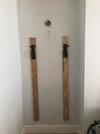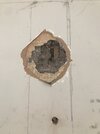Hey,
Relatively new DIYer here and this is my first post, any advice for this problem gratefully received!
I'm mounting OSB strips and hooks onto the party wall in the alcove of my Victorian terraced house. The idea is to hang bikes up from their front wheels.
The walls are 9 inch oooold crumbly brick with 2cm of old crumbly plaster over the top.
There should be three hangers side by side with the middle one about 20cm higher than the outer two - staggered so the bike handlebars don't tangle together.
I'm attaching pictures of what happened to the middle one - when I hung bikes from all three the middle one failed and pulled out of the wall taking a big load of plaster with it.
I've now realised (I think) that this is because the screw was nowhere near deep enough in the wall:
The screws I used were 60mm long, and I used red rawl plugs.
The plaster itself is 20mm thick.
The OSB+hook is 25mm thick.
So my screw was only 15mm into the brick, whereas I think for such a heavy item it should be at least 40mm into the brick (so the screws need to be at least 20+25+40mm long = 85mm)
I think the one that's failed was actually in the mortar not the brick, but reckon it's a matter of time before the others fail too.
So here's my idea for a remedy:
1. Remove all the existing plugs and drill deeper holes and insert 100mm frame fixings like these instead - https://www.screwfix.com/p/rawlplug...ck/73814#product_additional_details_container
2. Fix the broken plaster with Ronseal Big Hole smooth finish filler, which I can then drill into, slightly lower than the existing hole I've drilled
Any advice on whether this is a good idea or I need to consider something else would be really appreciated.
Also any advice on how to carefully remove the existing red rawl plugs without damaging the plaster.
Thanks a lot and sorry for the lengthy q!
Relatively new DIYer here and this is my first post, any advice for this problem gratefully received!
I'm mounting OSB strips and hooks onto the party wall in the alcove of my Victorian terraced house. The idea is to hang bikes up from their front wheels.
The walls are 9 inch oooold crumbly brick with 2cm of old crumbly plaster over the top.
There should be three hangers side by side with the middle one about 20cm higher than the outer two - staggered so the bike handlebars don't tangle together.
I'm attaching pictures of what happened to the middle one - when I hung bikes from all three the middle one failed and pulled out of the wall taking a big load of plaster with it.
I've now realised (I think) that this is because the screw was nowhere near deep enough in the wall:
The screws I used were 60mm long, and I used red rawl plugs.
The plaster itself is 20mm thick.
The OSB+hook is 25mm thick.
So my screw was only 15mm into the brick, whereas I think for such a heavy item it should be at least 40mm into the brick (so the screws need to be at least 20+25+40mm long = 85mm)
I think the one that's failed was actually in the mortar not the brick, but reckon it's a matter of time before the others fail too.
So here's my idea for a remedy:
1. Remove all the existing plugs and drill deeper holes and insert 100mm frame fixings like these instead - https://www.screwfix.com/p/rawlplug...ck/73814#product_additional_details_container
2. Fix the broken plaster with Ronseal Big Hole smooth finish filler, which I can then drill into, slightly lower than the existing hole I've drilled
Any advice on whether this is a good idea or I need to consider something else would be really appreciated.
Also any advice on how to carefully remove the existing red rawl plugs without damaging the plaster.
Thanks a lot and sorry for the lengthy q!



